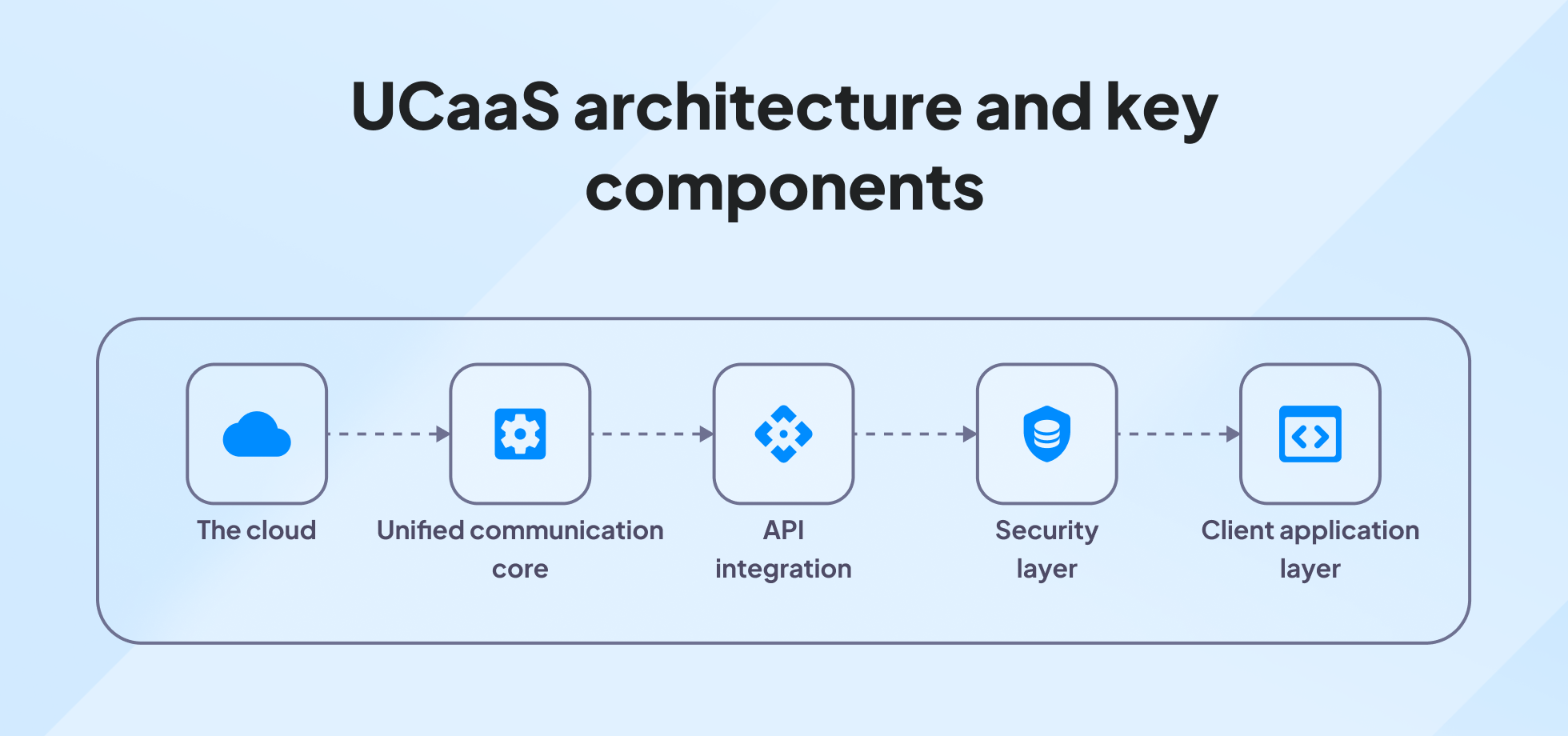
Unified Communications as a Service (UCaaS) has transformed business communications, offering an integrated platform that combines several key channels. This evolution began with the shift from traditional telephony to VoIP, which opened an avenue for cloud-based communications.
The rise of UCaaS reflects a response to the growing demand for flexible, scalable, and efficient communication tools in the digital age. In this article, we explore the definition of UCaaS, as well as its components, features, and benefits.
What is UCaaS?
UCaaS is a cloud-based delivery model for various communication and collaboration tools consolidated into a single unified platform. Common integrations include voice, video conferencing, instant messaging, and email.
Better data sharing, greater responsiveness and collaboration, and a workplace that is more effective and productive are all made possible by UCaaS. Its leaner and more agile communication framework also makes it easier to operate, lowers IT overhead, and does away with the need for several vendors.
When compared to traditional communication systems, UCaaS establishes itself as more focused on mobility and cost-effectiveness. We’ve illustrated the main difference between the two models in the table below:
ReliabilityDepends on the organization’s own investment in backup systemsDepends on the service provider’s backup systems
| Feature | Traditional Communication System | Unified Communications as a Service |
|---|---|---|
| Deployment | On-premise (hardware and infrastructure required) | Cloud-based (minimal physical infrastructure required) |
| Scalability | Low to moderate (requires additional hardware or licenses) | Very high (easy to add or remove services from a business package) |
| Cost | Higher upfront investment (purchasing and installing physical equipment) | Lower upfront investment (subscription-based model) |
| Maintenance | Managed by the organization in-house (requires specialized team) | Handled by the service provider (included in the service) |
| Flexibility | Low (tied to specific locations and hardware) | Very high (accessible anywhere, on any device) |
| Integration | Low (often requires custom solutions for integration) | Very high (built for easy integration with a wide range of apps and services) |
As opposed to CPaaS, which provides developers with APIs and SDKs to embed communication functionalities directly into their applications, UCaaS offers a more comprehensive, ready-to-use solution, making it an attractive option for businesses seeking an all-in-one communication solution without the need for custom development work.
How does UCaaS work?
To meet the needs of modern businesses, UCaaS solutions have a flexible and scalability-centric architecture comprising several key components.
- Cloud infrastructureThe backbone of UCaaS, the cloud contains data centers with servers and storage that host apps and manage data. It’s delivered easily over the Internet.
- Unified communications coreThe core includes the software that provides unified communications functionalities (voice, video, messaging, conferencing), as well as collaboration and management tools.
- Integration via APIsAPIs facilitate integration with other business applications and systems, such as CRM software and email platforms. This is what allows various tools to be connected.
- Security layerCloud UCaaS architectures incorporate robust security protocols, including encryption, authentication, and access control.
- Client application layerThese user interfaces are accessible on various devices, enabling users to interact with the UCaaS platform from anywhere.

So, how does UCaaS work? The cloud infrastructure is the foundation, hosting applications and managing data across data centers. The unified communications core, residing within the cloud, provides essential communication and data management functionalities.
This core is seamlessly integrated through APIs with external business applications, allowing for a unified workflow across different tools. The security layer ensures the integrity and confidentiality of data with encryption, authentication, and access control measures.
Finally, in the client application layer, users can access the UCaaS interface on various devices, giving them access to the platform’s services from anywhere in the world.
Key features of UCaaS
As the name suggests, UCaaS unifies several features that facilitate communication and collaboration under one roof. Here are the key ones:
Telephony
At the heart of any UCaaS platform lies a robust telephony system that utilizes AI contact center service and cloud PBX technology, allowing businesses to make and receive calls over the internet.
The system’s capabilities typically include call forwarding, recording, and advanced routing. More advanced features, such as visual voicemail and auto-attendant, are also made available by some service providers.
Voice and video conferencing
To meet the needs of modern businesses, UCaaS vendors offer comprehensive web conferencing capabilities on top of telephony. These include one-to-one and multi-participant calls, video calls, live client chats, and webinar systems.
Screen sharing and file sharing are also usually part of the package in order to facilitate seamless collaboration regardless of the participants’ location.
Instant messaging and email
UCaaS solutions are also known for their real-time communication capabilities through features such as text messaging, multimedia messaging, and email. Businesses can use these for a variety of purposes:

Cloud-based call center services
Cloud-based call center services are a part of the UCaaS offering, enhancing customer support capabilities with features like queue management, caller ID, and analytics. This allows companies to manage customer interactions more effectively, improving overall satisfaction.
CPaaS and integration with other apps
UCaaS systems are getting more adaptable as businesses continue to stray from communications solutions that are one-size-fits-all. UCaaS tools, which provide access to CPaaS (Communication Platforms as a Service) components and APIs, are currently being offered by numerous providers. Through APIs, users can create custom technology stacks by connecting various tools to their UCaaS system.
While some solutions allow developers free access to APIs, others have built-in interfaces with competitive partnership tools. A UCaaS system could be able to integrate with scheduling systems, project management software, worker engagement and management tools, video conferencing services, and CRM tools.
Several UCaaS providers integrate with CCaaS (Contact Center-as-a-Service) solutions as well, giving businesses access to all the resources they require for internal and external communications in a single, centralised location.
Benefits of UCaaS for business communications
Integrating a UCaaS platform into your business systems comes with several key benefits. Here are the main ones to consider:
- Cost efficiency and scalability. UCaaS solutions can significantly reduce upfront investment through its subscription-based model, allowing businesses to easily scale up or down based on their needs.
- Time-effective model. With all communication tools under one roof, UCaaS minimizes the time your staff spends switching between apps.
- Enhanced collaboration and mobility. Based in the cloud, the service can be accessed anytime and from anywhere. Its features enable seamless collaboration among teams.
- Improved reliability and security. Encryption protocols and built-in disaster recovery capabilities make UCaaS a secure choice for businesses of all sizes.
- Simplified IT management. The cloud-based model outsources maintenance, upgrades, and security, allowing IT teams to focus on other tasks.
- Unified user experience. UCaaS software offers users a unified experience when communicating with your brand, improving customer retention and loyalty.
How to choose a UCaaS provider
Selecting the right provider for your company depends on several key factors. To ensure that you have the best experience possible, consider a UCaaS platform that:
- Seamlessly integrates with your existing business apps
- Can scale alongside your business as it evolves
- Has a proven track record for reliability and uptime
- Meets industry-specific compliance requirements
- Offers prompt customer support
- Has a pricing model that fits your budget
Some of the top UCaaS providers to choose from are:
- Zoom – offers a robust UCaaS platform with video, voice, content sharing, and chat functionalities. It’s known for its ease of use, reliability, and high-quality video.
- Webex by Cisco – has a comprehensive suite of collaboration tools, including messaging, calling, and meetings. It’s recognized for its security, scalability, and integrations.
- Nextiva – integrates voice, video, messaging, analytics, and customer management in a user-friendly interface. It’s renowned for its high-quality customer support.
- 8×8 – provides a unified suite of voice, video, messaging, and contact center solutions. It has a global cloud communications network, making it a reliable international choice.
- RingCentral – offers a flexible and scalable UCaaS solution that includes team messaging, video meetings, and a cloud-based phone system. It has robust integration capabilities as well.
Implementing UCaaS in your business
Unified Communications as a Service can take your business to the next level if implemented properly into your daily operations. Below, you will find a step-by-step guide on how to do that successfully and ensure a smooth transition of operations into the cloud.
- Choose a provider according to your business needsTo get started with UCaaS, you must first understand the specific needs of your teams and how such a platform can address them. This will allow you to choose an appropriate provider offering scalable, reliable, and secure services.
- Plan the implementation and assess network capabilitiesAfter establishing what you want from a UCaaS solution and choosing a provider, it’s time to plan the implementation. Develop a detailed strategy that includes timelines, milestones, and responsibilities.
One crucial aspect to consider at the planning stage is network readiness. Assess your current network to ensure it can support the UCaaS solution. If needed, make some upgrades before proceeding with the implementation.
- Train all staff that will be using the UCaaS solutionIf you want the implementation process for your new UCaaS platform to be smooth sailing, you must train all relevant staff members before the launch. All employees using the new tools should receive demos and documents on how to do so effectively.
- Launch the project and gather feedbackYou’ve now reached the launch stage. If possible, do a soft launch first with just a few key staff members. Gather their feedback to see if any areas need improving before the full rollout.
- Monitor performance and optimize where neededOf course, gathering employee and customer feedback shouldn’t stop once your UCaaS solution is fully live. Continue to monitor the project’s performance and make adjustments where needed to optimize the system for your business needs.
Define KPIs for the project to measure the success of the implementation. You can then use these metrics to guide future enhancements.
Conclusion
The UCaaS model merges diverse communication tools into a cohesive cloud-based platform. Integrating telephony, video conferencing, instant messaging, and more enhances collaboration and mobility and offers significant cost savings and scalability.
As businesses navigate the complexities of modern communication, adopting a UCaaS solution is a strategic move towards streamlining operations and staying competitive.
Related articles
Top 20+ marketing tools for small businesses: Your essential 2025 guide to growth
Explore our selection of tools for online marketing,...
71 Customer satisfaction survey questions by user journey
Gathering customer feedback is crucial for improving...
How to use an employee text messaging system for internal staff communication
As traditional companies gradually get replaced by b...
The ultimate guide to professional appreciation emails: 16 Templates and best practices
Whether you’re thanking a customer for their b...
What is vishing? Unmasking voice phishing scams and techniques
Vishing, an insidious blend of voice communication a...




